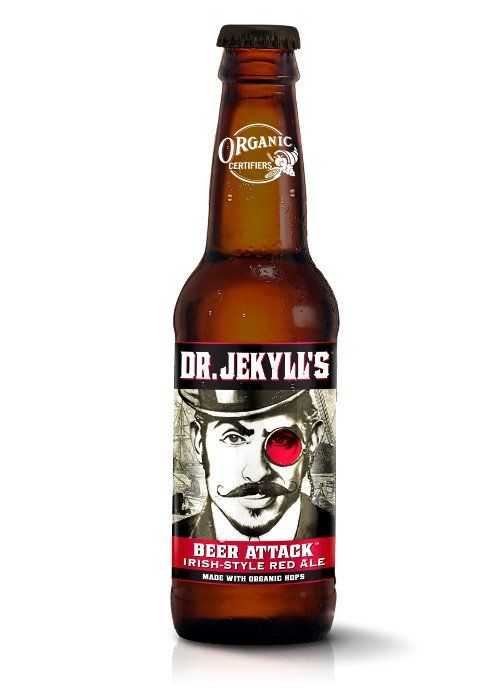Algae Ingredients Turn Heads in Food and Drinks
Algae address today’s demands for plant-based, sustainable ingredients.
Photo from Dr. Jeckyll's

Algae ingredients have found some success in food and drinks, most notably among them Life’sDHA vegetarian DHA omega-3 and TerraVia’s algal protein and lipid powder. Other algae ingredients, meanwhile, are still gaining footing in this promising market.
Nutritional Outlook checked in with a handful of algal-ingredient suppliers on how formulators can best take advantage of their ingredients in food and drink formulating.
Algae’s Time
Algae’s appeal has everything to do with how algae address today’s demands for plant-based, sustainable ingredients.
“Consumers want to purchase products that are healthy for both them and the environment,” says Greg Berthomieu, vice president, strategic partnerships, Stauber (Fullerton, CA). “You see them shopping at prime natural retailers, back to farmer’s markets, or via farm-to-fridge services for products that are unprocessed, organic, fair trade, eco-friendly, animal- or dairy-free, or vegan. Algae’s cultivation and harvest are, in most cases, sustainable, and algae typically provide very interesting nutritional profiles, so algae and algae-based ingredients fit right in with these new consumer trends.” His company, Stauber, distributes a unique, “clean-tasting” mineral-complex ingredient called Aquamin that is derived from Lithothamnion red algae and is rich in calcium and trace minerals.
David O’Leary, commercial manager at Marigot (Cork, Ireland), Aquamin’s creator, says the ingredient’s “unique, open, porous physical structure” provides food formulators numerous benefits. “With its unique structure, clean taste, and large surface area, it delivers a superior organoleptic profile in certain foods and beverages when compared to other calcium salts,” O’Leary says. Aquamin is suited for everything from bakery products to confectionery, snacks, smoothies, fruit juices, and vegetable drinks. (Dairy products are a lesser focus for now, he says, because “dairy producers already have dairy-based minerals immediately available, so there is less of a need to fortify with other sources.”)
Astaxanthin (primarily from Haematococcus pluvialis algae) is also expanding its food-and-drink footprint. In particular, confectionery products are a growing business, say the suppliers we spoke to.
Golan Raz, vice president, health and nutrition, LycoRed (Be’er Sheva, Israel), says her company sees growth for its astaxanthin in chewable confectionery products. And Karen Hecht, PhD, technical marketing specialist for AstaReal Inc. (Burlington, NJ), says AstaReal astaxanthin is doing business in chocolate bars such as Good Superfoods’ Superfood Chocolate Cocoa Mocha Coffeeberry bar.
Technical advancements are making it easier to formulate with astaxanthin. Hecht says AstaReal is now working to improve solubility and increase astaxanthin’s concentration in beverages and foods. Raz says that Lycored uses its proprietary microencapsulation technology to create 2% water-soluble starch beadlets enveloping Algatechnologies’ (Kibbutz Ketura, Israel) astaxanthin, which improves water solubility, stability, and temperature- and pH-resistance.
As for astaxanthin’s trademark red color, Hecht says the ingredient naturally “plays well with red or darker foods and beverages.” And while this may be a setback for some, others may like it, she says. “Consumers can look for the signature red hue of AstaReal natural astaxanthin and trust that they are getting nature’s strongest antioxidant.”
Finally, Raz points out another challenge for algae ingredients in food and beverage: “Price is the key challenge. The nutraceutical space isn’t as sensitive to price as food and beverage.”
If the Branding Fits...
As of now, algae are still distinctive enough in the food and beverage market to command attention. Take it from one who knows.
Tom Costa is the president and founder of craft beer brand Dr. Jekyll’s. The company’s Beer Attack Irish-Style Red Ale boasts some “peculiar” ingredients (the brand’s word) not commonly seen in beer, including maqui berry, hawthorn berry, cinnamon oil, flaxseed oil, and garlic. Also? Schizochytrium algal oil, which makes the beer heart-healthy thanks to the DHA and EPA omega-3 fatty acids from algae.
Costa says these functional oils are encapsulated before being added to the brew, ensuring the beer tastes great. “People care about taste first,” Costa says. “When they learn [the beer] has algal oil in it, many do not know what algal oil is. The ones who do absolutely love it! They appreciate what we are trying to do.”
Sometimes algae ingredients are also just the right fit with a brand’s image. Renowned surfer Laird Hamilton chose Aquamin’s mineral complex for his Laird Superfood Creamer. “This is a creamer that will be mixed with coffee, tea, or other beverages,” says Stauber’s Berthomieu. “Therefore, taste and dispensability of the ingredient are essential.” Aquamin not only checks both those boxes, but as Berthomieu points out, “The ocean origin of the ingredient and its sustainability are an excellent fit with Laird Hamilton’s affection for the big waves and respect of the environment.”
Also read:
Algae Continues to Expand in Food Market, Says TerraVia at IFT5 Plant Protein Ingredients for Food and Drink
Prinova acquires Aplinova to further increase its footprint in Latin America
April 7th 2025Prinova has recently announced the acquisition of Brazilian ingredients distributor Aplinova, which is a provider of specialty ingredients for a range of market segments that include food, beverage, supplements, and personal care.










